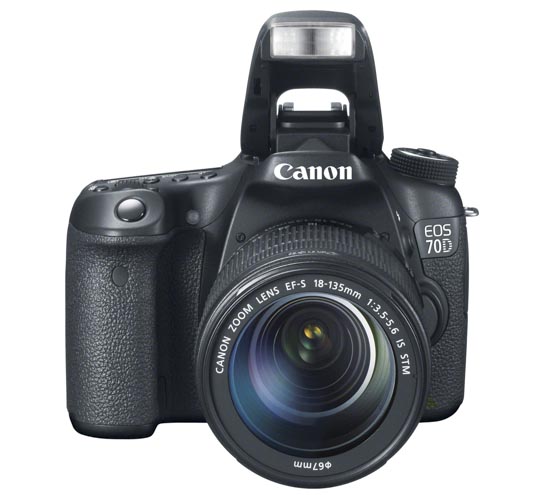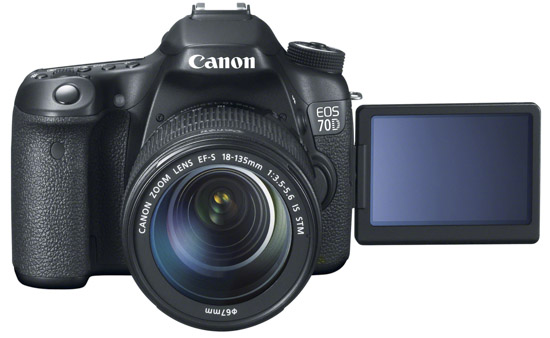Canon officially announced its new mid-range digital SLR camera, long waited Canon EOS 70D. You can see the full preview for EOS 70D here.
Canon EOS 70D is an APS-C camera with a brand-new 20.2MP “Dual Pixel CMOS AF” sensor and features 19-point AF module from the EOS 7D for viewfinder shooting, touchscreen control via its fully articulated 3″ LCD, and built-in Wi-Fi.
The brand new EOS 70D camera has been designed for photographers who are keen to explore and expand their shooting possibilities. It is equipped with a range of Canon technologies that make it possible to capture a wide variety of scenes and subjects in outstanding quality. Central to this ability is world-first, Canon-engineered Dual Pixel CMOS AF technology.
The new Canon EOS 70D digital SLR camera body only price is $1,199.00. The Canon EOS 70D is available to buy from the camera stores below.
Where to Buy Canon EOS 70D, Price and Order Options
| Store | Price | Amazon | Adorama |
|---|---|---|---|
| Canon EOS 70D Digital SLR Camera body only | $1,199.00 | Buy | Buy |
| Canon EOS 70D 20.2 MP Digital SLR Camera and EF-S 18-55mm F3.5-5.6 IS STM Kit | $1,349.00 | Buy | Buy |
| Canon EOS 70D 20.2 MP Digital SLR Camera and EF-S 18-135mm F3.5-5.6 IS STM Kit | $1,549.00 | Buy | Buy |
See also : Canon EOS 70D Sample Images and Videos
Click here for a short video explaining the technology and benefits and read on for a detailed account of how this system works.
Canon EOS 70D Dual Pixel CMOS AF Explained
What is Dual Pixel CMOS AF?
A Canon breakthrough sees twice the amount of photodiodes on the sensor, allowing phase-detection AF on the imaging sensor’s surface for the first time. Dual Pixel CMOS AF is a sensor-based, phase detection Auto Focus (AF) technology designed to provide smooth, high-performance focus tracking in movies and fast autofocus acquisition when shooting still photos in Live View mode.
It is a unique, Canon-developed technology, ideal for creating professional-looking pull-focus effects and keeping a subject moving towards the user in sharp focus while maintaining a blurred background – a defining characteristic of EOS Movies.
Thanks to this groundbreaking advance, capturing a subject and retaining sharp focus, even when moving, has never been easier.
Why was Dual Pixel CMOS AF developed?
Featuring a flip-out 3-inch LCD screen with 1040k dots for very high-resolution viewing of your images and movies, the EOS 70D is a very versatile tool for Live View and HD movie shooting.
With the ability to make a subject stand out with a limited depth-of-field, comes a requirement to keep control over focus, if the main subject moves or the point of focus changes. Dual Pixel CMOS AF was developed so that control of focus during movie making is made easier and smoother – removing the perceived notions that a DSLR’s movie mode is usable only to a professional. Additionally, Dual Pixel CMOS AF was developed to enhance the usability of shooting with Live View – moving even closer towards the same performance encountered when using the viewfinder.
The EOS 70D includes a high resolution Vari-Angle LCD that can be used to shoot a range of subjects from unusual and creative angles. A phase-detection auto focus system supports photographers and expands the range of subjects that can be captured.
The Dual Pixel CMOS AF array covers 80% of the total image sensor area so even off-centre subjects can be tracked with higher speed and greater accuracy.
How it works
The EOS 70D features a newly-designed Canon APS-C CMOS sensor with 20.2 million pixels. All effective pixels on the surface of the EOS 70D’s sensor consist of two individual photodiodes, which are read separately for phase-detection autofocus and together for imaging. Dual Pixel CMOS AF is possible over 80% of the width and height of the Live View frame and is highly accurate without compromising on image quality.
Unlike other methods of sensor-based autofocus, which allocate either autofocus or imaging functions to pixels on the sensor, the pixels on the EOS 70D’s CMOS sensor can be used as imaging pixels and phase detection AF pixels. As a result, no additional imaging processing is required around pixels dedicated for AF, which ensures both quick acquisition of focus and maximum image quality.
To perform phase detection on the image plane the EOS 70D reads left and right photodiodes independently and then calculates the phase-difference of the two parallax images.
All of Canon’s current range of EF and EF-S lenses are compatible with the Dual Pixel CMOS AF system.
By using this phase-difference AF technique the EOS 70D predicts the position the lens is in focus and moves it. By contrast, the more conventionally used contrast AF method looks for the focal position while moving the lens back and forth, so AF speed ends up being slower and not as smooth.
With face and object tracking engaged, Movie Servo AF follows a chosen subject as it moves, or when you recompose a shot. Alternatively, just select different focus areas by simply by tapping the touch-screen when recording.
At launch, Dual Pixel CMOS AF is compatible with 103 current EF lenses, spanning EF and EF-S, fixed focal length, wide-angle and telephoto lenses. The system marks a significant advancement in autofocus performance with greatly improved AF speeds.
The following EF lenses have limited compatibility with the Dual Pixel CMOS AF system :
- EF14mm f/2.8L USM
- EF24mm f/1.4L USM
- EF100mm f/2.8 Macro
- EF400mm f/2.8L USM
- EF500mm f/4.5L USM
- EF600mm f/4L USM
- EF1200mm f/5.6L USM
- EF16-35mm f/2.8L USM
- EF17-35mm f/2.8L USM
- EF20-35mm f/2.8L
- EF24-85mm f/3.5-4.5 USM
- EF28-70mm f/2.8L USM
- EF28-70mm f/3.5-4.5
- EF28-70mm f/3.5-4.5 II
- EF28-80mm f/2.8-4L USM
- EF28-80mm f/3.5-5.6
- EF28-80mm f/3.5-5.6 USM
- EF28-80mm f/3.5-5.6 II
- EF28-80mm f/3.5-5.6 II USM
- EF28-80mm f/3.5-5.6 III USM
- EF28-80mm f/3.5-5.6 IV USM
- EF28-80mm f/3.5-5.6 V USM
- EF28-105mm f/3.5-4.5 USM
- EF28-105mm f/3.5-4.5 II USM
- EF28-105mm f/4-5.6
- EF28-105mm f/4-5.6 USM
- EF35-70mm f/3.5-4.5
- EF35-70mm f/3.5-4.5A
- EF35-80mm f/4-5.6
- EF35-80mm f/4-5.6 PZ
- EF35-80mm f/4-5.6 USM
- EF35-80mm f/4-5.6 II
- EF35-80mm f/4-5.6 III
- EF35-105mm f/3.5-4.5
- EF35-105mm f/4.5-5.6
- EF35-105mm f/4.5-5.6 USM
- EF35-135mm f/3.5-4.5
- EF35-135mm f/4-5.6 USM
- EF70-210mm f/3.5-4.5 USM
- EF70-210mm f/4
- EF75-300mm f/4-5.6
- EF80-200mm f/2.8L
- EF80-200mm f/4.5-5.6
- EF80-200mm f/4.5-5.6 USM
- EF80-200mm f/4.5-5.6 II
- EF90-300mm f/4.5-5.6
- EF90-300mm f/4.5-5.6 USM
- EF100-200mm f/4.5A
- EF100-300mm f/4.5-5.6 USM
- EF100-300mm f/5.6
- EF100-300mm f/5.6L


